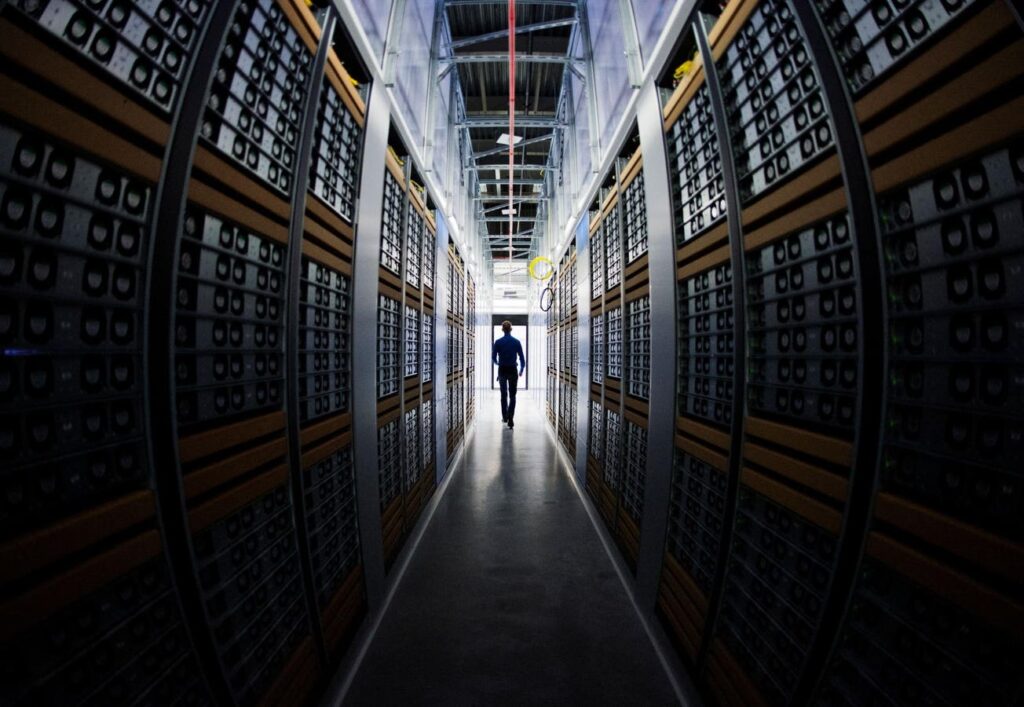Companies are spending as if money was going out of style to buy the hardware needed to build and operate generative AI chatbots.
How so? Cloud services providers and others could invest $300 billion into AI hardware in 2024, according to an analysis by Sequoia Capital featured in Tom’s Hardware. Nvidia gets about half of this investment and providers of servers, cooling hardware, energy and other data center components get the other half,
Can these investments ever pay off? The answer depends mostly on two things:
- How you define the payoff.
- Whether a killer app for generative AI ever emerges.
If the payoff is defined as earning enough profit to offset the investment — which Sequoia estimates would require the likes of AWS and other tech giants to generate $600 billion in generative AI revenue — such a payoff could be decades away.
To put Cahn’s estimates in perspective, the largest tech companies — Alphabet, Amazon, Apple, Meta and Microsoft — are budgeting an estimated $400 billion in capital expenditures, mostly on AI-related hardware and R&D, according to The Economist.
In light of the $2 trillion in market capitalization these five technology giants have added in the last year, investors are projecting the companies will add between $300 billion and $400 billion to their top lines, The Economist reported.
There is a huge gap between the additional generative AI-driven revenue implied by the rise in their stock market capitalization and what the five companies will deliver in 2024. “Even bullish analysts think Microsoft will make only about $10bn from generative-ai-related sales this year,” noted The Economist.
If the payoff is defined as adding enough revenue to sustain expectations-beating growth that boosts the tech giants’ stock prices, a payoff could happen in the next few years.
In my view, this outcome will only happen if a killer app — as the electronic spreadsheet was for personal computers or the iTunes store was for the iPod — emerges for generative AI.
Sequoia’s Estimates Generative AI Hardware Investment
AI companies will have to generate about $600 billion a year in revenue to pay for their AI hardware, according to an estimate from Sequoia Capital analyst David Cahn.
The AI companies making the investment include “AWS, Google, Meta, Microsoft, and many others” that spent money on AI hardware for applications such as OpenAI’s ChatGPT, noted Tom’s Hardware.
To arrive at his $600 billion revenue figure, Cahn made the following assumptions:
- Nvidia GPU purchases. In the fourth quarter of 2024, Nvidia will generate $150 billion in annualized GPU revenue, he estimated.
- Other AI hardware purchases. Other data center costs — for energy, buildings, and backup generators — will require an investment equal to twice the cost of Nvidia’s AI GPUs. AI data center hardware costs in Q4 2024 will total $300 billion, according to Cahn.
- Software margins. Profit margins on software are 50%, he noted.
- Software required to pay back AI hardware investment. To generate the $300 billion in profit required to payback the $300 billion in AI data center costs, Cahn estimated the companies would need $600 billion in new generative AI revenue.
While this model is a useful start, I see room for improvement. Here are some suggestions:
- Extend payback period. Cahn assumes companies expect to earn back their AI hardware investment in a year. A more typical payback period is three to five years. Assuming “an aggressive three years, then that $600 billion becomes $200 billion per year,” according to a July 8 email from analyst Jon Peddie.
- Slowdown in AI hardware investment. Cahn assumed the growth in GPU spending will rise 66% by the end of 2024. At some point, that growth rate will slow down as demand for AI chatbots slows. This slowdown is likely unless a killer app for generative AI emerges.
- Different groups of companies are investing in AI hardware with different profit margins. Cahn’s model assumes software revenue will generate the profit required to payback the investment in AI hardware. In fact, probably the largest group of companies investing in AI hardware are cloud services providers — which have lower profit margins than software companies do.
Having said that, Cahn estimates AI revenue falls $500 billion short of what he thinks is required to payback the $600 billion AI hardware investment.
This gap assumes there is $100 billion in AI revenue being generated in 2024. Google, Microsoft, Apple, and Meta are each estimated to generate $10 billion in annual revenue from AI while companies including Oracle, ByteDance, Alibaba, Tencent, X, and Tesla are forecast to generate $5 billion each, according to Tom’s Hardware.
Based on The Economist’s generative AI revenue estimates, the actual gap may be larger.
Finally, Cahn assumed that this $500 billion gap — if not closed — would result in a bubble poised to burst.
Since the companies investing in AI hardware are not financing the purchases with debt, they face no urgency to repay the investment. Simply put, AWS and the other cloud services providers are paying cash for their AI hardware.
The companies are not facing investor pressure to earn back the cash because many of them —notably Microsoft and Meta Platforms — are so profitable that their biggest risk is not keeping up with the fastest-growing market opportunities.
Will Generative AI Value Network Payoff The Investment?
Various companies in the generative AI value network are buying AI hardware. According to my new book, Brain Rush, these include:
- AI cloud services providers;
- AI data centers;
- Large language model suppliers;
- Data management, application performance monitoring, and networking technology providers; and
- Generative AI application developers.
Each of these groups has different levels of investment in AI hardware, varying cash positions, and a range of average profit margins. For example, in 2023 Microsoft and Meta had high cash positions — $111 billion and $66 billion, respectively, and fat profit margins — 34% and 29%, respectively, with limited debt, according to the Wall Street Journal.
Amazon — whose AWS generated $25 billion in revenue and enjoyed a 38% operating margin in 2024’s first quarter, according to The Register — has a good cash position — but a much lower net margin, and significant long-term debt. Specifically, in 2023 Amazon had $87 billion in cash, a net margin of 5.3%, and $136 billion in long-term debt, noted the Journal.
Simply put, the additional generative AI revenue Microsoft and Meta would need to payback their AI hardware investment is likely to be smaller than Amazon will require due to the wide differences in the companies’ relative profitability.
While some of these companies report how much capital they are investing in AI hardware and other assets, they do not quantify their AI revenue in dollar terms. It could be a long time before their AI revenue is high enough to report as a distinct line item.
If history is any guide, it could be years before a killer app that drives significant revenue emerges for generative AI. For example, the first PC, the Kenback 1, was introduced in 1971 and it was not until 1979 that Visicalc, the first electronic spreadsheet hit the market — giving many more people a compelling reason to buy a PC.
Another killer app was the iTunes store. In 2001, Apple launched the iPod — which did not enjoy significant demand until the iTunes store launched in April 2003, CNN noted.
While I don’t know when it will happen, I think a killer app for generative AI will be at the top of the value pyramid, about which I wrote in a June 2024 Forbes post. The pyramid consists of three levels:
- Overcome creator’s block. At the base of the pyramid are the many ways people use AI chatbots to get started on an activity — such as writing an email or a report, creating a photo or video, or coding software. By helping overcome creator’s block, AI chatbots can increase people’s productivity. This is the easiest way for businesses to get value now. However, since other companies can do the same, the advantage from using AI to overcome creator’s block is fleeting.
- Boost customer service and sales productivity. The middle layer of the value pyramid can increase a company’s productivity. For example, in the temporary job placement industry, generative AI can reduce significantly the number of candidates a recruiter sends to a company before finding a match. AI chatbots can also help a company to resolve customer questions more rapidly. It is unclear whether companies will pay a high enough price for such AI applications to enable their suppliers to grow profitably.
- Create new growth curves. The top level of the pyramid is the most valuable one. AI technology suppliers aspire to create new growth curves for their business by helping their customers grow faster. In general, if generative AI can deliver faster growth, that growth will drive up the stock price of companies deploying the AI-powered applications — thus making them more willing to pay a high price for the technology.
There is much more real activity going on in the first and second levels of the pyramid than in the third, according to Brain Rush.
Generative AI Bubble Won’t Burst Yet
Bubbles are much worse when companies borrow money to expand them. So far, the only kind of debt companies are taking on for generative AI is so-called technical debt — meaning “all of the anticipated (and unanticipated) costs businesses incur when deploying new technology,” noted theWorks.
Examples include “fixing software bugs that couldn’t be dealt with at launch; installing patches after unknown vulnerabilities emerge; and the costs of modernizing legacy tech infrastructure,” theWorks reported.
While there does not seem to be a meaningful amount of financial debt being taken on to buy generative AI hardware, investors should be concerned about revenue expectations debt.
Simply put, unless the billions invested in AI hardware result in significantly higher revenue growth rates, investors’ expectations will not be met.
Such disappointment would drive down the stock prices of Microsoft, Google, Amazon and Meta Platforms — along with shares of their GPU supplier, Nvidia.
Read the full article here





